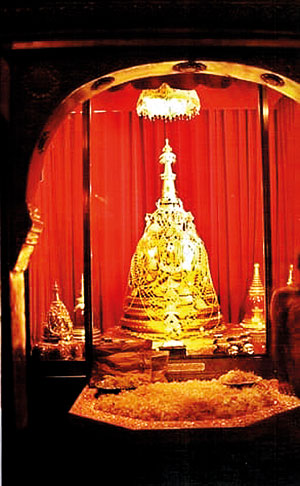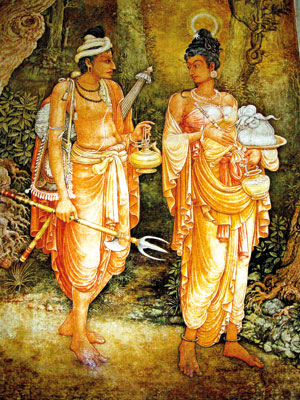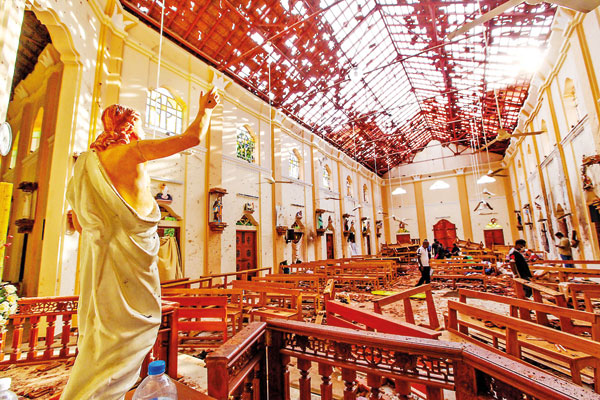Columns
All roads lead to Kandy as Sri Dalada Vandana begins
View(s):
- How divine right to rule concept brought sacred Tooth Relic to Lanka
Even as Avurudhu blossoms lay strewn and wilted on the ground, a million lotuses bloomed to let their sweet fragrance waft the air as the sacred Sri Dalada exposition began on Friday in Kandy‘s Maligawa, in hushed reverential worship.
After Monday’s annual Suriya Namaskar, Friday saw the start of the Sri Dalada Vandana for a period of ten days. The last time an exposition of the Sri Dalada had been held for the public to behold was 16 years ago.

SACRED SRI DALADA: Exposition
From Friday, with all roads leading to Dalada Maligawa, the nation took on a refreshing religious retreat in worship before it descends—eight days later—once again into the hurly-burly gutter of Pradeshiya Sabha politics with the government determined to pull it off and thus complete the election hat trick at any cost.
They seem to suffer the belief that possession of the Executive and Parliament alone will not suffice, but control of village councils is of total necessity to be bestowed by the sovereign people with the divine right to rule Lanka as they deem fit.
The divine right of kings to rule in perpetuity, with throne, crown and sceptre passing down the royal bloodline, where the king’s word was law, which none could question without getting his head chopped off, was theorised by Hegel to justify absolute monarchy in England and elsewhere. Despite King Charles the First losing his head over the doctrine, it still survives in Britain and Europe, albeit in a limited form of a constitutional monarchy.
The concept can also be found in ancient India, where it bestowed on mortal kings the religious and political legitimacy to wear the crown and bear the sceptre of kingship. In fact, it was the legitimate right of anyone who had the Buddha’s Tooth Relic under his custody that led to conflicts among states and brought the Buddha’s sacred Tooth Relic to the isle of Lanka, to find its lasting seat.
The chequered journey of the sacred Tooth Relic begins shortly after the Great Passing Away of the Buddha. Once the raging fire of the sandalwood pyre finally ends its gluttonous dance, Arahant Khema retrieves from the burnt remains the left canine tooth of the Noble One.
She bestows it to King Brahmadatta of Kalinga in Eastern India for worship and safety in his kingdom. As later events show, she has chosen wisely. King Brahmadatta, and subsequent kings of Kalinga, become the royal guardians of the sacred relic. For nine hundred years—after the pyre’s consuming flames had yielded the relic to Arahant Khema—they guard the entrusted ‘saririka’ relic of the Buddha with extreme vigilance and care. They successfully repel the attacks; ambitious kings of other states ruthlessly wage to possess the sacred Tooth Relic as evidence of their legitimate right to rule the land .
But trouble is afoot.

ROYAL SAGA: Prince Danta and Hema Mala
King Guhasiva is on the Kalinga throne. Heretic King Pandu of Pataliputta steals or captures the Tooth Relic with intent to destroy the intent of veneration. The heretical King’s hatred stems from repeatedly hearing claims made against King Guhasiva of keeping the relics of a dead man. But he himself later embraces Buddhism and, in remorse, returns the relic to Guhasiva.
But King Pandu’s nephew, reigning monarch of the neighbouring state, has other ideas. In a bid to consolidate his power base, he takes recourse to war against Guhasiva to wrest possession of the Tooth Relic as a symbolic sign of his own legitimacy to rule the land. But the Kalinga King senses, well in advance, distant drums of approaching war.
During this turbulent period, Prince Dante of Ujjaini arrives in Kalinga to pay due homage to the Tooth Relic. King Guhasiva gives his daughter Princess Hema Mala’s hand in marriage to Prince Dante, who is also made the custodian of the sacred Buddha Relic.
Guhasiva dies in the battle for the Tooth Relic, but his triumphant foe finds an empty casket, with its priceless jewel missing.
The missing jewel that millions had worshipped for over 900 years, with utmost faith and fervour, is presently hid within the long, tied-up tresses of a woman’s head. The wise Guhasiva had conspired in advance the manner in which he would deny the warring usurper, the Buddha’s Tooth Relic.
Not for nothing had he betrothed his daughter to Dante and made him the protector of the sacred Tooth Relic. Now in the guise of commoners, Prince Dante and his royal Queen Hema Mala were on their way aboard ship from Kalinga’s eastern seaport. And none of the king’s men, searching for the treasure, know or suspect that it’s hidden inside Hema Mala’s tied and knotted casket of hair.
Thus does Hema Mala, braving imminent death if caught, bring the ‘Saririka Dhathu’—Relic of the Buddha’s body—rescued from the burning ashes of the sandalwood pyre nine hundred years before by Arahant Khema, a royal wife of King Bimbisara, who had become an Arahant while a laity—to the isle of Lanka in the 4th century AD.
Five hundred years before King Guhasiva’s daughter Hema Mala brought the sacred Tooth Relic to Lanka hidden in her hair, King Asoka’s daughter, Sanghamitta Theri, sails into the port of Dambakola Patuna near Jaffna, bringing in a bowl, her sire’s supreme living gift to Lanka’s King Devanampiyatissa, a sapling of the Great Bodhi tree that had given shelter to Siddhartha to attain Buddhahood.
To these three great females in Buddhist history who rendered an immune service to the Dhamma by spreading Buddhism far beyond Bharat’s shores, to Sanghamitta for bringing the ‘Paribogika Dhathu’—an object used by the Buddha—the Jayasri Maha Bodhi; and to Hema Mala for bringing the ‘Saririka Dhathu’, the sacred Tooth Relic of the Buddha, to the isle of Lanka, Lanka’s Buddha Sasana owes an irrepayable debt of gratitude. This should be borne in mind when denying women their right to be ordained as Bhikkhunis or banning a bevy of girls from dancing at the main Kandy Perahera.
With Danta and Hema Mala landing on Lankan soil, they proceed as instructed by Hema Mala’s sire, King Guhasiva, to the capital of Lanka, Anuradhapura. Guhasiva had, through trade, developed a friendship with King Mahasen, and they had been told to hand the precious Tooth Relic to the King for safekeeping since it was under threat in Kalinga, with war drums beating to take the Relic by military force.
But by the time the royal couple arrive in Anuradhapura, King Mahasen is dead. His son, the successor to his throne, King Siri Meghavanna, receives the sacred Tooth Relic with great veneration; and later enshrines India’s gift of gifts, which, according to a 14th-century text, ‘Dalada Sirita’ at the Megha-giri Vihara, now known as Isurumuniya.
Thus begins the reign of the Sri Dalada in Lanka, undisturbed for over six centuries at its capital seat, Anuradhapura.
But tumultuous times lie ahead for Anuradhapura. The capital’s demise begins with the Cholas invading the city ramparts and ends with them taking King Mahinda the 5th, as captive to India in 1017 AD. With their conquest complete, they will rule for the next 53 years until a prince from the south emerges to reclaim the throne of Lanka.
His name, Kitti. Twice he attempts to wrest Polonnaruwa free from Chola rule. Twice he fails. But undaunted, he launches a three-pronged battle to regain the land.
A force is sent along the western shore to Mahathittha port to prevent Chola reinforcements from South India. The second force attacks from the eastern flank, while the prince himself leads from the front, the main army from the northwest.
The strategy succeeds. After 53 years in Chola grip, Polonnaruwa falls. The triumphant prince marches into the city with his army behind, and proclaims himself as King Vijayabahu of all Lanka.
But if Anuradhapura’s reign as the capital was a day, Polonnaruwa’s is but an hour. Despite Polonnaruwa’s splendour, achieved under two visionary kings, Vijayabahu the First and Parakramabahu the Great. It doesn’t possess the same resilience as the former capital did. The Polonnaruwa era lasts till 1215 AD.
During this period, however, starting from building the Atadage to enshrine the sacred Tooth Relic to the complex network of tanks and canals to irrigate the surrounding lands, Lanka experiences a revival in prosperity under Vijayabahu’s visionary watch. Upon his death, a shadow falls on Polonnaruwa. The momentum he had set in motion loses its energy and dies.
His son, Vickramabahu, succeeds him but soon proves he’s of a different mettle, unfit to wear the crown. His crime? The Culawamsa says, dipping his hands into the till box of the Temple of the Tooth and plundering its offerings. Wising up to the king’s habit, and unbeknown to him, temple monks smuggle the Tooth Relic out of Polonnaruwa and lodge it in the custody of Queen Sugala in the Kingdom of Ruhuna.
Parakramabahu ascends Lanka’s throne in 1153; he is without the sceptre of the sacred Tooth Relic, bereft of legitimacy. During his tenure as king, many entreaties are made for its return, but it’s of no avail. He is refused at every turn. It’s only after waging war that he retrieves the Tooth Relic.
Though history garlands him with the accolade ‘the Great’ for his military success in reuniting the country under one banner and for unleashing the engineering skills of the Sinhala genius in building the Parakrama Tank or Samudra, his 30-year reign is one fraught with intrigues and internecine wars.
With his death in 1186, the sun begins to set on Polonnaruwa, and soon darkness falls on the Sinhala Kingdom. Magha of the Kalingas invades the island and soon overruns Polonnaruwa. The splendour that was Polonnaruwa remains in total eclipse for hundreds of years to come.
After nearly 150 years of ruling the newly founded capital of Lanka, the Sinhala Kingdom takes flight. It’s on the run. Its southbound descent, from pit stop to pit stop, starts.
Its nomadic existence, like a travelling circus, will continue for nearly four hundred years. And sharing in the vicissitudes of the Sinhala Kingdom’s fate is the sacred Tooth Relic, the sceptre and the staff, though denied the throne, that signifies the legitimate right of Sinhala kings to rule the land.
Dambadeniya is the first retreat. Then it’s Yapahuwa and on to Kurunegala. Then down to Gampola and further down to the Kotte Kingdom. But with Portuguese colonialists arriving on Lanka’s shores in 1509, Kotte comes under threat. The decision is taken to remove the Tooth Relic to its last stop in the coastal region: Seethawaka, the last independent Sinhala kingdom in the lowlands.
But its own safety remains uncertain. With the fall of Kotte, the Sinhala Kingdom moves to the hills. In 1595, the sacred Tooth Relic is taken from Seethawaka by King Wimaladhamasuriya of the Udarata Kingdom, the final seat of residence of the Sri Dalada.
Throughout the Dalada Odessey, from the shores of Kalinga to its highland resort in Kandy, both king and commoner have enshrined the Sri Dalada to their bosoms and protected its safety with their lives at every stage of its journey.
Despite 700 years of foreign domination, despite sinister efforts to crush the spirit and stub the faith, this nation remains Buddhist to the core.
| No mastermind revealed yet of Easter Sunday’s massacre Six years ago, while the world was celebrating the resurrection of Jesus Christ, Lanka was counting its dead, fallen while at prayer on Easter Sunday in three churches in various places in the land. They were the innocent victims of five deadly terrorist bomb explosions. The death toll: 269. The injured: over 600. Husbands and wives who came to pray left as widows or widowers. Children left as orphans, even as parents were made to mourn the loss of a child. Some who entered the church hale and hearty left coffined home; some robust in health and fitness went homebound, maimed for life. All who witnessed the unfolding outrage in the Temple of God that Easter Sunday morn risked being mentally scarred for life, and they may no longer behold the joy of life without a tinge of pain. Why, in God’s name, did those fanatical religious terrorists blow themselves up to kingdom come? They asked for no ransom, took no hostage, what gain did they expect to receive in heaven? Or hell? Father, forgive them, for they did not know what they did that Easter Sunday.  RESURRECTION: After crucifixion. Jesus rises again Why did they strike, what was the gain, and who the mastermind? Do we need to know, or must we wait until the inscrutable ways of Providence reveal the truth to us? By what scale on this earth, can justice measure the value of a drop of innocent blood? Or, in the manner the Cardinal’s lawyer, President’s Counsel Shammil Perera, urged earthly justice from a manmade court in Lanka for the families of the dead and for those that were maimed in the Easter attack, to receive compensation from the State, and received it, must the Cardinal urge the Government of the day to reveal the mastermind to receive justice for the dead and maimed? Will his relentless quest to know the mastermind end, should the government spring a suspect and name as the mastermind behind Easter’s tragedy? Or should we throw up our hands in despair, invoke Heaven’s divine retribution to fall on the guilty? Perhaps Nemesis has already knocked on the mastermind’s door? The nation should profoundly undergo a change of hearts and minds, as Saul underwent on the road to Damascus. The Sunday Punch wishes readers: BLESSED EASTER. | |
Buying or selling electronics has never been easier with the help of Hitad.lk! We, at Hitad.lk, hear your needs and endeavour to provide you with the perfect listings of electronics; because we have listings for nearly anything! Search for your favourite electronic items for sale on Hitad.lk today!


Leave a Reply
Post Comment